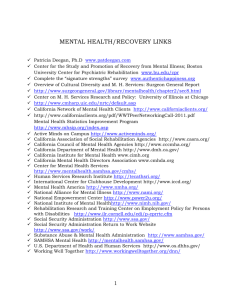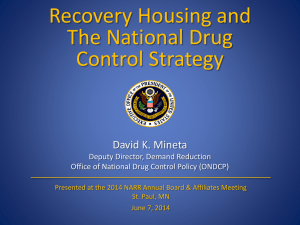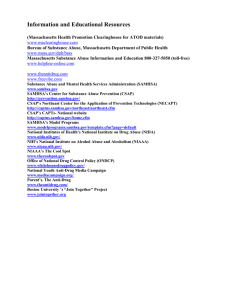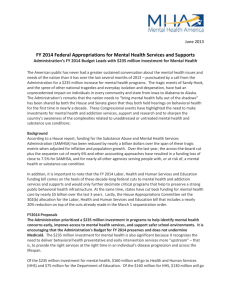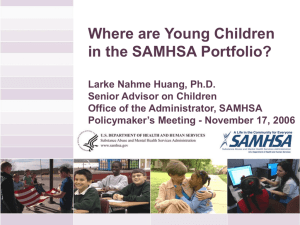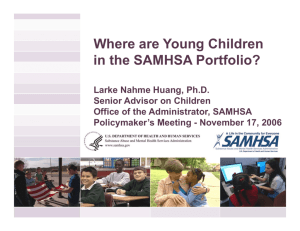Improving Lives and Capitalizing on Emerging Opportunities
advertisement
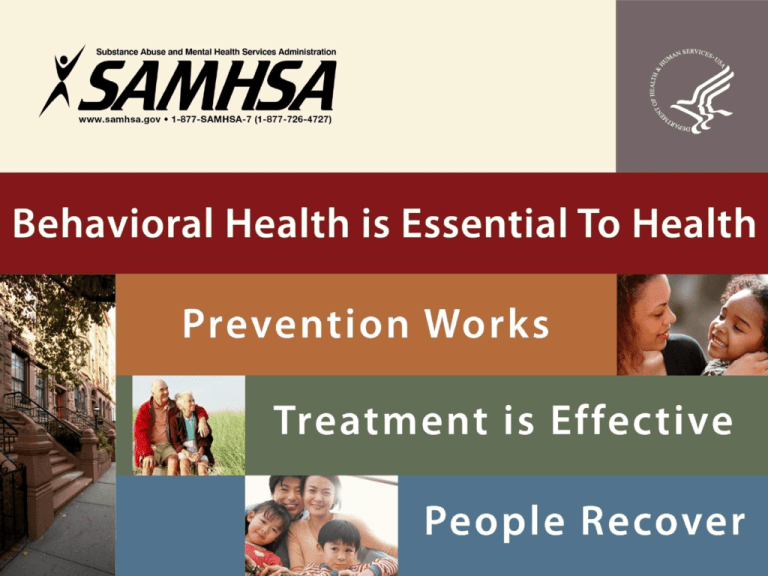
Improving Lives and Capitalizing on Emerging Opportunities Pamela S. Hyde, J.D. SAMHSA Administrator ACHMA Harnessing Disruptive Innovations New Orleans, LA • March 18, 2011 Lynn’s Story 3 Working mom and wife who struggled with an unknown health condition for close to 20 years Doctors ordered test after test to determine what was wrong Lynn’s health continued to deteriorate As she missed more and more days at work her medical files grew Knew she was going to die unless she found out what was wrong Finally (after two decades) her addiction to alcohol was recognized Later on through treatment she learned about the mental health problems that were confounding her situation Now a loving grandmother gainfully employed and living a healthy life in recovery James’ Story 4 55 year old Veteran who struggled with addiction for 24 years Entered numerous treatment facilities and was incarcerated two times Diagnosed with AIDS in the late 1980’s Began attending Narcotics Anonymous meetings and quit using illicit drugs Entered college and is currently working on his dissertation for his Doctorate Currently employed as a Behavior Clinician with a mental health treatment court program Asher’s Story 5 13 years old; an eighth-grader Straight-A student Victim of bullying • Small size • Religion • Clothing • Sexual Identity Tragic loss - died by suicide Tough Times = Tough Choices 6 Staying focused in times of rapid change may be the single most important thing we can do to guide our field forward SAMHSA’S FOCUS 7 People - NOT money People’s lives - NOT diseases Sometimes focus so much on a disease/condition we forget people come to us with multiple diseases/conditions, multiple social determinants, multiple cultural attitudes CHALLENGES & OPPORTUNITIES The Art of Possibility, authors Rosamund Stone Zander and Benjamin Zander share this story: • A shoe factory sends two marketing scouts to a region of Africa to study the prospects for expanding business • One sends back a telegram saying: SITUATION HOPELESS_ STOP_ NO ONE WEARS SHOES • The other writes back triumphantly: GLORIOUS BUSINESS OPPORTUNITY_ STOP_ THEY HAVE NO SHOES CONTEXT OF CHANGE 9 Budget constraints, cuts and realignments Economic challenges like never before No system in place to move innovative practices and systems change efforts that promote recovery to scale Science has evolved; language is changing Integrated care requires new thinking about recovery, wellness, and the related practices and roles of peers in responding to whole health needs New opportunities for behavioral health (Parity/Health Reform/Tribal Law and Order Act) DRIVERS OF CHANGE 10 Health Reform SAMHSA’s Theory of Change 11 SAMHSA’s FY 2012 BUDGET REQUEST $3.6 BILLION (A NET ↑ $67 MILLION OVER FY 2010) 12 Commitment to Behavioral Health Focus on SAMHSA’s Strategic Initiatives Implements a Theory of Change Efficient and Effective Use of Limited Dollars SAMHSA FY 2012 BUDGET REQUEST HIGHLIGHTS 13 $395 million - Substance Abuse – State Prevention Grants $90 million - Mental Health – State Prevention Grants $50 million - Behavioral Health - Tribal Prevention Grants (allocated from ACA Prevention Funds) Mental Health Block Grant ↑ $14 million ( three percent - largest increase since 2005) Substance Abuse Block Grant ↑ $40 million (three percent) BUDGET REFLECTS THEORY OF CHANGE 14 Innovation and Emerging Issues Highlights: • Military Families ($10 million) • Health Information Technology ($4 million) • Housing – Services Assisting in the Transition from Homelessness ($154 million, ↑ of $12 million) • SBIRT – ($29 million) • Prevention Prepared Communities ($23 million) • Suicide Prevention ($48 million) • Primary/Behavioral Health Care Integration ($34 million) SAMHSA LEADING CHANGE 15 Mission: To reduce the impact of substance abuse and mental illness on America’s communities Roles: • • • • • Leadership and Voice Funding - Service Capacity Development Information/Communications Regulation and Standard setting Practice Improvement Leading Change – 8 Strategic Initiatives HHS STRATEGIC PLANS SAMHSA STRATEGIC INITIATIVES 16 AIM: Improving the Nation’s Behavioral Health 1 2 3 4 Prevention Trauma and Justice Military Families Recovery Support AIM: Transforming Health Care in America 5 Health Reform 6 Health Information Technology AIM: Achieving Excellence in Operations 7 Data, Outcomes & Quality 8 Public Awareness & Support PREVENTION CHALLENGES 17 Reduced perception of harm Increasing rates of illicit drug use and prescription drug misuse >half (55.9 percent) of youth and adults who use prescription pain relievers non-medically got them from a friend or relative for free ~5,000 deaths each year attributable to underage drinking Adults who begin drinking alcohol before age 21 more likely to have alcohol dependence or abuse than those who had their first drink after age 21 >34,000 suicides occurred in the U.S. in 2007; 100 suicides per day; one suicide every 15 minutes • ~30 percent of deaths by suicide involved alcohol intoxication – BAC at or above legal limit SAMHSA STRATEGIC INITIATIVE PREVENTION 18 Prevent Substance Abuse and Mental Illness (Including Tobacco) and Build Emotional Health Prevention Prepared Communities (PPCs) Suicide Underage Drinking/Alcohol Polices Prescription Drug Abuse TRAUMA AND JUSTICE CHALLENGES 19 Substance abuse or dependence rates of prisoners are more than four times that of the general population Youth in juvenile justice have high rates of M/SUDs • Prevalence rates as high as 66 percent; 95 percent experiencing functional impairment More than 80 percent of State prisoners, 72 percent of Federal prisoners, and 82 percent of jail inmates meet criteria for having either mental health or substance use problems • More than 41 percent of State prisoners, 28 percent of Federal prisoners, and 48 percent of jail inmates meet criteria for having both, contributing to higher corrections costs On any given day, veterans account for nine of every hundred individuals in U.S. jails and prisons SAMHSA STRATEGIC INITIATIVE TRAUMA AND JUSTICE 20 Public health approach to trauma Trauma informed care and screening; trauma specific service ↓ impact of violence and trauma on children/youth ↑ BH services for justice involved populations • Prevention • Diversion from juvenile justice and adult criminal justice systems ↓ impact of disasters on BH of individuals, families, and communities MILITARY FAMLIES CHALLENGES 21 2009: M/SUDs caused more hospitalizations among troops than any other cause Service members back from deployment: ~ 18.5 percent with PTSD or depression and ~ 19.5 percent with traumatic brain injury ~ 50 percent of returning service members who need treatment for mental health conditions seek it - slightly more than half receive adequate care 2005 – 2009: More than 1,100 members of the Armed Forces took their own lives; an average of 1 suicide every 36 hours 2010 Army suicide rate among active-duty soldiers ↓ slightly; number of suicides in the Guard and Reserve ↑ by 55% • More than half of the National Guard members who died by suicide in 2010 had not deployed 2009: Any given night, ~107,000 veterans were homeless SAMHSA STRATEGIC INITIATIVE MILITARY FAMILIES 22 Improve access of military families to community-based BH care Help providers respond to needs within military family culture Promote BH of military families with programs and evidence-based practices • Support resilience and emotional health • Prevent suicide Develop effective and seamless BH service system for military families RECOVERY SUPPORTS CHALLENGES 23 Up to 83 percent of people w/SMI are overweight or obese People w/SMI have shortened life-spans, on average living only until 53 Those with M/SUDs consume 44 percent of all cigarettes in U.S. 64 percent of persons who are homeless have an alcohol or SUD Any given night in U.S. > 643,000 homeless; ~63 percent individuals and 37 percent adults w/children Since 2007: 30 percent ↑ in number of homeless families Of the >6 million people served by MHAs ~ 79 percent are unemployed yet only 2.1 percent receive evidence-based supported employment services In 2009: Unemployed adults were classified wSUDs at ↑ rate (16.6 percent) than were full (19.6 percent) or part time (11.2 percent) employed adults Individuals with M/SUDs often lack socially valued activity, adequate income, personal relationships, recognition and respect from others, and a political voice RECOVERY SUPPORT 24 HOME ↑ Permanent Housing HEALTH ↑ Recovery Individuals and Families PURPOSE ↑ Employment/ Education COMMUNITY ↑ Peer/Family/ Recovery Network Supports HEALTH REFORM CHALLENGES 25 Individuals Served by SSAs Individuals Served by MHAs Insured 39% Uninsured 39% Uninsured 61% Insured 61% •90-95 percent will have opportunity to be covered Medicaid/Insurance Exchanges HEALTH REFORM CHALLENGES 26 In 2014, 32 million more Americans will have health insurance • Between 20 to 30 percent of these people (6 to 10 million) will have a M/SUD More than one-third (35 percent) of all SAPTBG funds used to support individuals in long-term residential settings • Residential services are generally not covered under Medicaid • Some States spend 75 percent of their public behavioral health funds on children in residential settings CMS spends $370 billion on dual eligibles and ~60 percent of these individuals have a mental disability SAMHSA STRATEGIC INITIATIVE HEALTH REFORM 27 Ensure BH included in all aspects of health reform Support Federal, State, Territorial, and Tribal efforts to develop and implement new provisions under Medicaid and Medicare Finalize/implement parity provisions in MHPAEA and ACA Develop changes in SAMHSA Block Grants to support recovery and resilience and ↑accountability Foster integration of primary and behavioral health care HEALTH REFORM IMPACT OF AFFORDABLE CARE ACT 28 More people will have insurance coverage • ↑Demand for qualified and well-trained BH professionals Medicaid will play a bigger role in M/SUDs Focus on primary care & coordination with specialty care Major emphasis on home & community-based services; less reliance on institutional care Theme: preventing diseases & promoting wellness Focus on quality rather than quantity of care ACA FIRST YEAR HIGHLIGHTS 29 Significant program changes • Home visiting • Primary Care/Behavioral Health Integration Major insurance reform • Youth to age 26 • No pre-existing condition –children • High risk pools Changes affecting publicly insured: • States receiving matching federal funds – low income individuals and families • 3M “donut hole” checks to Medicare individuals • Round 2 of “Money Follows the Person”—heavy focus on BH • Health Homes for individuals with chronic conditions • Medicaid 1915i Redux—very important changes • Prevention and Public Health Trust Funds awarded • Community Health Centers expanded – serving 20 million more individuals • Loan forgiveness programs – primary , nurses and some BH professionals WORK AHEAD SAMHSA 30 Continued work on BG applications Establishment of health homes/ACOs with TA to States Work on Exchanges – policies and operations Essential benefits / benchmark plans Decisions/implementation of prevention funds Regulations – home and community base services Evidence of good and modern services • Benefit decisions • Practice protocols • Research agenda HEALTH REFORM STATE ROLES 31 General ● Role as payer expanding ● Role in preparing State Medicaid programs now for expansion in 2014 (enrollment, benefit plans, payments, etc.) ● Role in HIT expanding ● Role in high risk pools unfolding ● Role in insurance exchanges unfolding through HHS ● Role in evaluating insurance markets and weighing against possible benefits of new exchanges SSAs and MHAs ● ● ● ● New kind of leadership required with state agencies Change in use of block grants (moving demos to practice) Supporting communities selected for discretionary grants Work with public health and primary care HEALTH REFORM CONSUMER ROLES 32 Learn • Continue educating yourself/others on implications of HR Participate • Continue working with your states Advocate • Continue making your voice heard to further shape HR • Continue motivating America to better understand behavioral health is essential to health BRSS TACS WORK AHEAD PROVIDERS 33 Increase in numbers insured elevates workforce issues ~One-third of SA providers and 20 percent of MH providers have no experience with third party billing 10 percent of all BH providers have a nationally certified EHR Few have working agreements with health centers Many staff w/o credentials required through practice acts MCOs SAMHSA working with provider organizations: • Billing, EHRs, Compliance, and Access PROVIDERS ROLES TO CONSIDER IN HEALTH REFORM ENVIRONMENT 34 Promote collaboration Learn about new health care landscape and educate other people in recovery Form/join a coalition regarding parity/health reform Involve people in recovery and promote consumer directed care Identify gaps in coverage and services Advocate for consumer-friendly enrollment processes Promote high quality and integrated care Promote prevention and wellness Understand the economic environment— tough choices for States Be clear about what is important to guide these tough choices With so much changing need to stay focused on people we serve SUPPORTING EFFORTS OF PROVIDERS 35 To support providers in these roles, SAMHSA has established: • Technical assistance centers • Posted resources such as tip sheets, webinars, and timelines available at www.samhsa.gov/healthreform • Additional resources are located at www.healthcare.gov, a highly interactive website that can help people find health coverage and provides in depth information about the ACA HIT CHALLENGES 36 20 percent of 175 substance abuse treatment programs surveyed, had no information systems, e-mail, or even voicemail Only 8.2% of community mental health centers surveyed in 2009 had interoperable systems with medical and primary care systems IT spending in BH and human services organizations represents 1.8 percent of total operating budgets (compared to 3.5 percent of for general health care services) half of BH and human services providers possess fully implemented clinical electronic record systems State and Territorial laws vary on extent providers can share medically sensitive information, such as HIV status and treatment for psychiatric conditions SAMHSA STRATEGIC INITIATIVE HEALTH INFORMATION TECHNOLOGY 37 Develop infrastructure for EHRs • Privacy • Confidentiality • Data standards Provide incentives and create tools to facilitate adoption of HIT and EHRs with BH functionality in general and specialty health care settings Deliver TA to State HIT leaders, BH and health providers, patients and consumers, and others to ↑ adoption of EHRs and HIT ↑ capacity for exchange and analysis of EHR data to assess quality of care and improve patient outcomes DATA, OUTCOMES, AND QUALITY CHALLENGES 38 Fragmented data systems reinforce the historical separateness of systems of care Discrete approaches to treatment Distinct funding streams for state mental health, substance abuse, and Medicaid agencies Data requirements are not consistent across programs Separate treatment systems create—access barriers, uneven quality, disjointed coordination, and information silos across agencies and providers SAMHSA STRATEGIC INITIATIVE DATA, OUTCOMES, AND QUALITY 39 Integrated approach – single SAMHSA data platform Common data requirements for states to improve quality and outcomes • Trauma and military families • Prevention billing codes • Recovery measures Common evaluation and service system research framework • For SAMHSA programs • Working with researchers to move findings to practice • Improvement of NREPP as registry for EBPs PUBLIC AWARENESS AND SUPPORT CHALLENGES 40 What Americans Believe: 66 percent believe treatment and support can help people w/MI lead normal lives 20 percent feel persons w/MI are dangerous to others Two thirds believe addiction can be prevented 75 percent believe recovery from addiction is possible 20 percent say they would think less of a friend/relative if they discovered that person is in recovery from an addiction 30 percent say they would think less of a person with a current addiction SAMHSA STRATEGIC INITIATIVE PUBLIC AWARENESS AND SUPPORT 41 Understanding of and access to services Cohesive SAMHSA identity ● SAMHSA branding ● Consolidation of websites ● Common fact sheets ● Single 800 # Consistent messages – communications plan for initiatives ● Use of social media Tools to improve policy and practice ↑Social inclusion and ↓discrimination NATIONAL DIALOGUE ON ROLE OF BEHAVIORAL HEALTH IN PUBLIC LIFE 42 Tucson, Fort Hood, Virginia Tech, Red Lake, Columbine Violence in school board and city council meetings, in courtrooms and government buildings, on high school and college campuses, at shopping centers, in the workplace and places of worship In America: > 60 percent of people who experience MH problems and 90 percent of people who need SA treatment do not receive care In America: Suicides almost double the number of homicides How do I know when someone is having a mental health crisis? We know universal sign for choking We know facial expressions of physical pain We recognize blood and other physical symptoms of illness and injury What can I do to help? We know basic terminology around physical illness, accidents, and injury We know basic First Aid and CPR for physical crisis SAMHSA PRINCIPLES 43 People ● Partnership ● Stay focused on the goal Cannot do it alone Performance ● Make a measurable difference www.samhsa.gov
